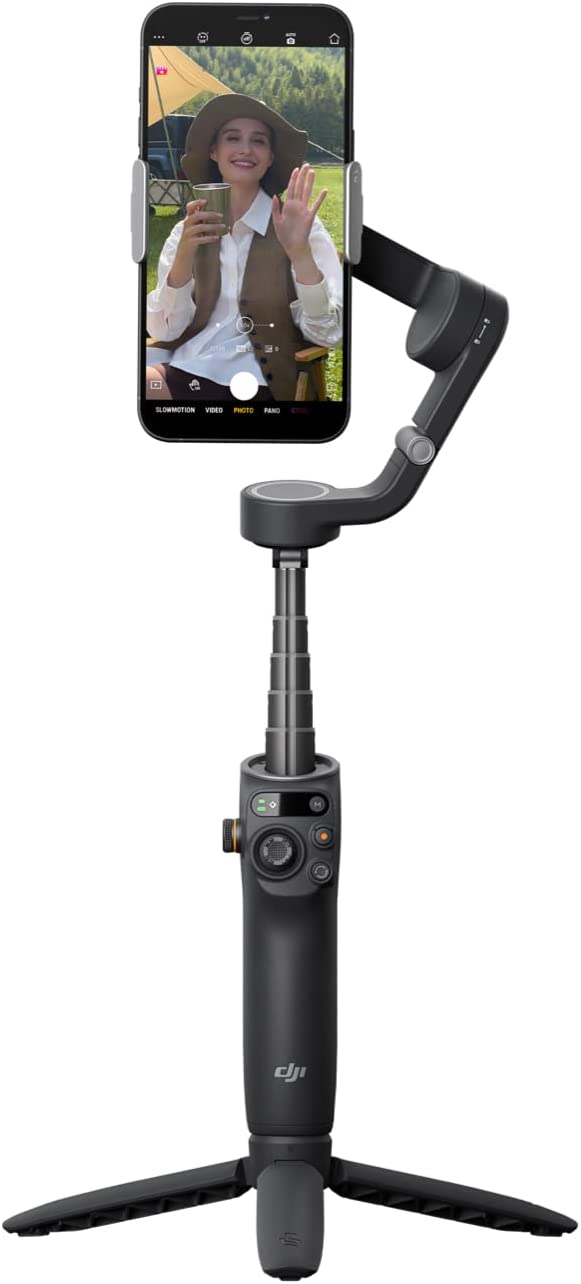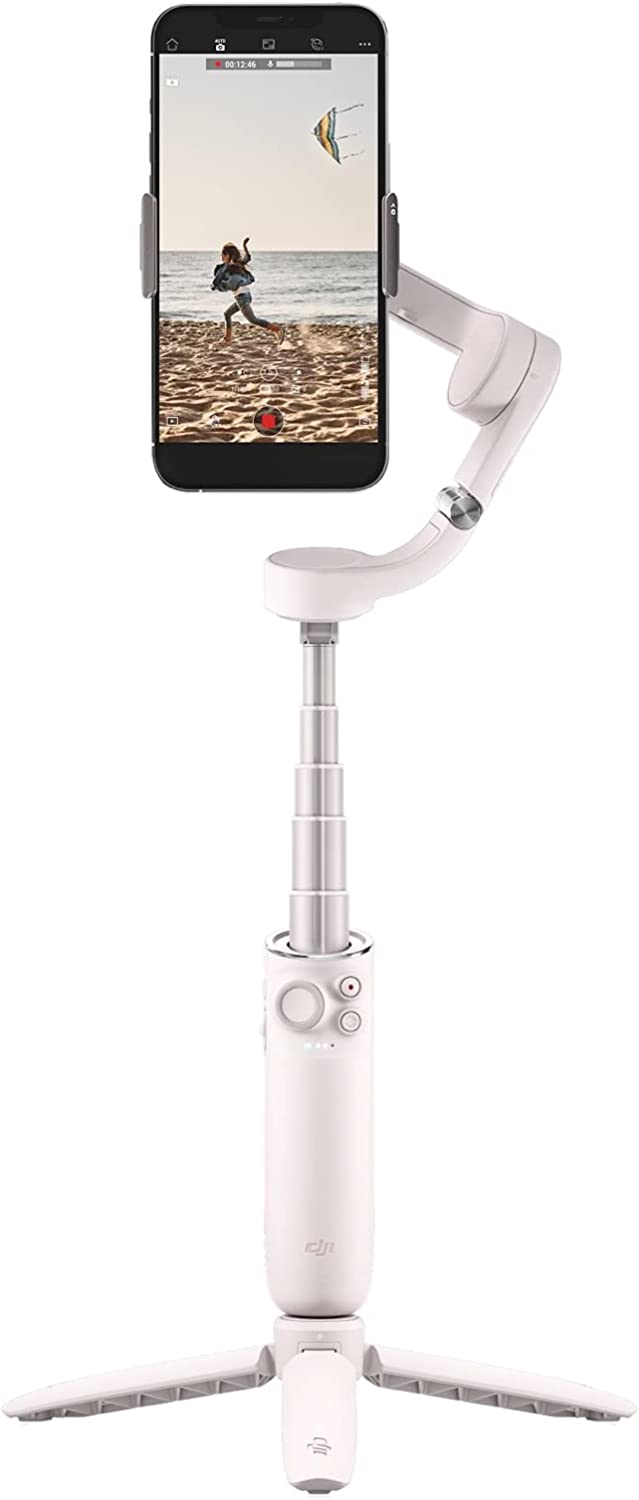|
Our favourite! DJI Osmo 6
Weight: 304 grams |
Good opinions! DJI Osmo 5
Weight: 292 grams |
How many times have we thought: “If I could relive this moment…”? The truth is that there are experiences and moments that are only lived once in a lifetime, but they can be immortalized! The smartphones that we have today allow us to capture the best images of each moment, although they do not always have the same quality and, above all, stability. And we want to talk about this in this comparison, in which we show you the most important differences between the DJI Osmo 6 vs DJI Osmo 5 image stabilizers.
Let us tell you that, until not long ago, we were one of those who thought that these types of accessories were “too top” to use them. Until we tried them and verified the difference when viewing the images recorded with and without a stabilizer. And, if you are a content creator, this type of accessory is part of your professional kit, without a doubt. Now, you don’t have to be an influencer to want to have the best quality videos and images.
DIJ Osmo’s image stabilizers are one of the most reputable on the market, and no wonder. We start from the basis that it is one of the most important imaging technology brands, and it has a wide catalog that proves it. Specifically, mobile stabilizers are one of its most flexible and versatile products, because they are perfect for moving anywhere. And, between these two models, it is necessary to analyze aspects such as operational efficiency or the rotation mechanism, which are the ones that will make the main difference. Check why!
DJI Osmo 6 vs DJI Osmo 5 – Comparison Table
If you want to know what are the differences to take into account between the two mobile image stabilizers, we encourage you to take a look at this comparative table.
DJI Osmo 6
|
DJI Osmo 5
|
|
| Folded dimensions | 189 × 84,5 × 44 mm | 174,7 × 74,6 × 37 mm |
| Unfolded dimensions | 276 × 111,5 × 99 mm | 264,5 × 111,1 × 92,3 mm |
| Available colours | Grey | Gray and white |
| Weight | 304 grams | 292 grams |
| Axes | 3 | 3 |
| Fit smartphones width | 67-84 mm | 67-84 mm |
| Arm length | 215 mm | 215 mm |
| Battery Type | Li-Po 2S | Li-Po 2S |
| Cattery capacity | 1000 mAh | 1000 mAh |
| Operating time | 6.5 hours | 6.5 hours |
| Loading time | 1 hour and 24 minutes | 1 hour and 30 minutes |
| Pan range | From −161.64° to 173.79° | From −161.2° to 172.08° |
| Rotation | From −120.30° to 211.97° | From −127.30° to 208.95° |
| Inclination | From −101.64° to 78.55° | From −101.64° to 78.55° |
| Maximum control speed | 120°/s | 120°/s |
| Bluetooth | 5.1 | 5.0 |
| App | DJI Mimo | DJI Mimo |
| Tripod diameter | 32 mm | 32 mm |
| Active Track | 6.0 | 4.0 |
| Quick start | Yes | No |
| Recording guides | Yes | Yes |
From bichrome to monochrome

Aesthetically, we can verify that the design line is quite similar in both stabilizers, as are the dimensions and weight (the millimeter differences, we are not going to mention them). Now, DJI has moved from offering a dual color option on the DJI Osmo 5, which can be purchased in white and grey, to a monochrome range on the DJI Osmo 6.
This model can be purchased in platinum gray or slate gray, although in both cases the color is grey. We can also verify that the DIJ Osmo 6 has a wheel on one of its sides that is not on the Osmo 5, we will tell you what it is for later. Another difference that we detect between them is that the DIJ Osmo 6 has a status panel in which we can check how much battery is left or switch between operating modes. A kind of screen that gives it a technological touch superior to that of the Osmo 5.
Other than these differences, there are no other significant design changes to the gimbal, which takes up virtually the same amount of space when folded or unfolded in both cases. You can also check that the two stabilizers have 3 axes.
Running and charging time
Regarding the battery that the two stabilizers have, it should be noted that the brand has not implemented improvements in this regard. Both integrate a 2S Li-Po battery, with a capacity of 1000 mAh, and an approximate autonomy of 6.5 hours. As for the time it takes to recharge it, it is an hour and a half in both cases. According to the brand, there is a difference of 6 minutes, although for us this cannot be called a difference.
Active Track Update

If you’ve used a DJI Image Stabilizer before, you’ll know that Active Track is the technology DJI uses to track stationary or moving targets such as vehicles, boats, or people. The DJI Osmo 5 has Active Track version 4.0, which is updated to 6.0 on the DJI Osmo 6. What does this translate into? Mainly, in the degree of precision when following a moving target. In turn, this makes for more powerful visuals, even when zoomed in, as the fluidity of movement is much smoother.
Quick Start only on DJI Osmo 6
A novelty that the DJI Osmo 6 presents compared to its rival is that it has a quick start option, and it turns on automatically when we deploy it. Thus, you can start recording more quickly in case you see something you want to immortalize and it is moving, so you can not waste time turning on the stabilizer. You just have to pair it with your mobile, and you can start recording as soon as you deploy the stabilizer.
Control wheel
Before we mentioned that the DJI Osmo 6 has a small wheel that the Osmo 5 does not have. It is a wheel that allows you to control the rotation, zoom and focus more precisely, and in a 360º frame. Therefore, the sharpness and quality when capturing details is greater thanks to millimeter precision.
What image modes does each stabilizer have?
Another important element when choosing an image stabilizer is knowing what are all the available recording modes in each one. The DJI Osmo 6 has several templates, among which are:
- TimeLapse – and all speed related templates such as MotionLapse and HyperLapse.
- Dynamic Zoom: modes to zoom in and out more clearly.
- Gesture control: it is used to stylize the image in case you want to do several poses that do not move.
- Panoramic – The DJI Osmo 6 features three panoramic view options, CloneMe, 3×3, and 240º.
- FPV mode: its function is to ensure that the 3 axes follow the movement of the main objective.
- SpinShot: it is a mechanism to control the rotation using the joystick.
- Fixed Tilt – The camera view only follows the gimbal pan movements and stays stable when tilting and rotating the gimbal.
The DJI Osmo 5 has many of these options, except for gesture control and one of the panoramic view modes. In addition, it incorporates the Story mode, which allows you to create a short mini video as if you were telling a story. Of course, the two stabilizers have ShotGuides, recording guides that will help you maintain the perfect frame.
Technological applications

As a good content creator, you know that all the images and videos that are recorded (or the vast majority) require editing. In this sense, you should know that the two stabilizers are linked to the DJI Mimo app, where you can consult all the tutorials that will help you optimize the use of the stabilizer, as well as the different configuration options.
The DJI Osmo 6 also goes from the DJI Mimo app to the LightCut app, which allows video editing based on artificial intelligence, and has a wide variety of templates.
DJI Osmo 6 vs DJI Osmo 5: Is it worth upgrading?
The answer to this question is very subjective, and depends on several factors. But, after having weighed the pros and cons, it seems to us that the evolution that the DJI image stabilizer has had is very good. The DJI Osmo 6 delivers higher quality, more accurate results with near-perfect fluidity and detail.
A degree of sophistication that, perhaps, is interesting for people who are dedicated to creating audiovisual content at a professional level, but that, from our point of view, is worth it. The price is higher, and for this reason we believe that the update would be considered in profiles whose work depends on the quality of the images. Now, if you are a hobbyist and small details do not make a big difference to you, the DJI Osmo 5 is a very interesting stabilizer that does its job very well.
However, the DJI Osmo 6 goes a step further in control, degree of rotation and fluidity of movement. It also incorporates more options and recording modes, and combines the use of the usual app with an editing app based on artificial intelligence. That being said, it is only up to you to know what are the priority aspects that will help you make a decision. In any case, DJI is a brand that never fails.


